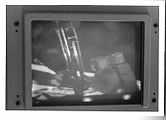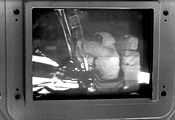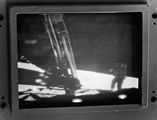Apollo 11 missing tapes
The Apollo 11 missing tapes refers to Apollo 11's slow-scan television (SSTV) telecast recorded in its raw format on telemetry data tape during the time of the first Moonlanding in 1969. The recordings were discovered to be "missing" after a team of retired NASA employees and contractors tried to locate the tapes in the early 2000s. The data tapes were recorded as a backup in case the live television broadcasts failed for any reason. In order to broadcast the SSTV transmission on standard television, NASA ground receiving stations performed real-time scan conversion to the NTSC television format. The moonwalk's converted video signal was broadcast live around the world on July 21, 1969 (UTC). At the time, the NTSC broadcast was recorded on many videotapes and kinescope films: they were never missing.
The search was sparked when several still photographs appeared in the late 1990s that showed the superior-looking raw SSTV transmission on ground station monitors. The research team conducted a multi-year investigation in the hopes of finding the most pristine and usable versions of the moonwalk. If the original SSTV format tapes were to be found, more modern digital technology could make a higher-quality conversion, yielding better images than those originally seen. The researchers discovered that the tapes containing the raw unprocessed Apollo 11 SSTV signal were erased and reused by NASA in the early 1980s. This was according to NASA's procedures, as they were facing a major data tape shortage at that time.
Although the researchers never found the telemetry tapes they were looking for, they did discover the best visual quality NTSC videotapes as well as super 8 movie film taken of a video monitor in Australia, showing the SSTV transmission before it was converted. These visual elements were processed in 2009, as part of a NASA approved restoration project of the first Moonwalk. At a 2009 news conference in Washington, D.C., the research team released its findings regarding the tapes' disappearance. They also partially released newly enhanced footage obtained during the search. Lowry Digital completed the full Moonwalk restoration project in late 2009.
Background


Limited radio bandwidth was available to transmit the video signal, which needed to be multiplexed with other communication and telemetry channels beamed from the Lunar Module back to the Earth.[1] Therefore, Apollo 11's moonwalk video was transmitted from the Apollo TV camera in a monochrome SSTV format at 10 frames per second (fps) with 320 lines of resolution, progressively scanned.[2] These SSTV signals were received by radio telescopes at Parkes Observatory, the Goldstone tracking station and Honeysuckle Creek tracking station.[3] The camera's video format was incompatible with existing NTSC, PAL and SECAM broadcast television standards. It needed to be converted before it could be shown on broadcast television networks. This live conversion was crude. Simply stated, it was a video camera pointed at a 10-inch TV monitor.
Video signal processing
Since the camera's scan rate was much lower than the approximately 30 fps for NTSC video,[Note 1] the television standard used in North America at the time, a real-time scan conversion was needed to be able to show its images on a regular TV set. NASA selected a scan converter manufactured by RCA to convert the black-and-white SSTV signals from the Apollo 7, 8, 9 and 11 missions.[4]
When the Apollo TV camera radioed its images, the ground stations received its raw unconverted SSTV signal and split it into two branches. One signal branch was sent unprocessed to a fourteen-track analog data tape recorder where it was recorded onto fourteen-inch diameter reels of one-inch-wide analog magnetic data tapes at 3.04 meters per second.[5] The other raw SSTV signal branch was sent to the RCA scan converter where it would be processed into an NTSC broadcast television signal.[5]
The conversion process started when the signal was sent to the RCA converter's high-quality 10-inch video monitor where a conventional RCA TK-22 television camera — using the NTSC broadcast standard of 525 scanned lines interlaced at 30 fps — merely re-photographed its screen. The monitor had persistent phosphors, that acted as a primitive framebuffer.[6] An analog disk recorder, based on the Ampex HS-100 model, was used to record the first field from the camera.[6] It then fed that field, and an appropriately time-delayed copy of the first field, to the NTSC Field Interlace Switch (encoder). The combined original and copied fields created the first full 525 line interlaced frame and the signal was then sent to Houston.[6] The disk recorder repeated this sequence five more times, until the camera imaged the next SSTV frame.[6] The converter then repeated the whole process with each new frame downloaded from space in real-time.[7] In this way, the RCA converter produced the extra 20 frames per second needed to produce flicker-free images to the world's television broadcasters.[4]
This live conversion was crude compared to early 21st-century electronic digital conversion techniques. Image degradation was unavoidable with this system as the monitor and camera's optical limitations significantly lowered the original SSTV signal's contrast, brightness and resolution. If the scan converter's settings were incorrectly set, as they were at the Goldstone station during the first few minutes of Apollo 11's Moonwalk, the negative impact on the image could be very obvious.[8] When Armstrong first came down the Lunar Module's ladder, he was barely visible because the contrast and the vertical phase were not set correctly by the scan converter operator.[8] The video seen on home television sets was further degraded by the very long and noisy analog transmission path.[9] The converted signal was sent by satellite from the receiving ground stations to Houston, Texas. Then the network pool feed was sent by microwave relay to New York, where it was broadcast live to the United States and the world.[10]
NTSC broadcast tapes
This low quality optical/analog electronic conversion of the Apollo 11 Moonwalk video images, made with a TV camera taking pictures of a video monitor, is what was widely recorded in real time onto kinescope film and NTSC broadcast-quality 2-inch quadruplex videotape. Recordings of this conversion were not lost and have long been available to the public (along with much higher quality video from later Project Apollo missions). If the one-inch data tapes, with the raw unprocessed Apollo 11 SSTV signals on them, were to be found, modern digital technology would allow for significantly better conversion and processing.[3] The quality would be similar to what a few technicians and others saw at SSTV receiving ground stations before it got converted to NTSC.[11] An amateur 8 mm film movie with about 15 minutes of Apollo 11 SSTV images, taken from another monitor before the conversion step, was rediscovered in 2005 and is available on DVD.[12]
Search for the missing tapes


News that these analog data tapes were missing broke on August 5, 2006 when the printed and online versions of The Sydney Morning Herald published a story with the title One giant blunder for mankind: how NASA lost moon pictures.[13] The missing tapes were among over 700 boxes of magnetic data tapes recorded throughout the Apollo program which have not been found.[14] On August 16, 2006 NASA announced its official search saying, "The original tapes may be at the Goddard Space Flight Center … or at another location within the NASA archiving system", "NASA engineers are hopeful that when the tapes are found they can use today's digital technology to provide a version of the moonwalk that is much better quality than what we have today."[15] NASA also had ongoing research reasons for finding these higher resolution tapes; since the now discontinued Constellation program was planned to carry out tasks similar to those of the original Apollo program.[16]
The Goddard Center's Data Evaluation Laboratory has the only known surviving piece of equipment which can read the missing tapes and was set to be closed in October 2006, causing some fear that, even if the tapes were later found, there would be no ready way to read and copy them.[17] However, equipment that could read the tapes was maintained.[3]
On November 1, 2006 Cosmos Magazine reported that some NASA telemetry tapes from the Apollo project era had been found in a small marine science laboratory within the main physics building at Curtin University of Technology in Perth, Western Australia. One of these tapes was sent to NASA for analysis.[18] It carried no video but did show that if any of the tapes are ever found, data could likely be read from them.[19]
NASA news conference
NASA held a news conference at the Newseum, in Washington, D.C. regarding the missing tapes on July 16, 2009 – the 40th anniversary of Apollo 11's launch from Cape Kennedy.[20] The multi-national research team looking into the missing tapes – made up mostly of retired engineers that worked on the original broadcast in 1969 – was represented at the event by Richard Nafzger from the Goddard Space Flight Center, and Stanley Lebar, the former lead engineer at Westinghouse that developed the Apollo Lunar Camera and the Apollo Color Camera.[9] They concluded that the data tapes – with the SSTV signal – were shipped from Australia to Goddard and then routinely erased and reused a few years later.[20] Australian backup tapes were also erased after Goddard received the reels.[3] The SSTV signal was recorded on telemetry data tapes mostly as a backup in case the real-time conversion and broadcast around the world failed. Since the real-time broadcast conversion worked, and was widely recorded on both videotape and film, the backup video was not deemed important at the time.[3] In the early 1980s, NASA was facing a severe data tape shortage for its Landsat program, and it was likely during this period that the tapes were erased and reused.[19]
There was also documentation that two hours of the Apollo 11 moonwalk SSTV were recorded at the Parkes, Australia facility on modified Ampex 2-inch helical scan VTRs. The VTRs were modified by Johns Hopkins University's Applied Physics Labs to record 320-line slow-scan video directly to the videotape without converting it.[3] It was confirmed that these tapes were shipped to Johns Hopkins University, but were not locatable by the search team.[3]
Nafzger stated that they did find several post-conversion copies of the broadcast that were higher quality than what was previously seen by the public.[20] Their findings included: a videotape recorded in Sydney after the conversion but before the satellite transmission around the world; videotape from CBS News archives (direct from NASA, without commentary); and kinescopes at Johnson Space Center.[20] At the news conference, it was mentioned that Lowry Digital would complete enhancing and restoring the tapes.[20] Mike Inchalik, president of Lowry Digital, mentioned that they would only restore the video and not remove defects (such as reflections that looked like flag poles) that their software could remove.[3] A few short clips were shown at the news conference, showing the improved quality from the restored broadcast tapes.[20]
NASA released some partially restored samples on their website after the news conference.[21] The full restoration of the footage, about three hours long, was completed in December 2009.[19] Some other footage surfaced through John Sarkissian's efforts, that showed SSTV video of Armstrong's descent and first steps from the Australian ground stations' feeds.[22] Highlights of this fully enhanced video were shown to the public for the first time at the Australian Geographic Society Awards on October 6, 2010, where Buzz Aldrin was the guest of honor.[23]
See also
| Wikinews has related news: Erroneous newspaper report garners publicity for Moon landing tapes |
- Apollo TV camera
- Lunar Orbiter Image Recovery Project
- Project Apollo
- Moon landing
Notes
- ↑ For the purposes of clarity and simplicity in this article, 60 fields and 30 frames per second are used. NTSC actually runs at 59.94 fields per second, and 29.97 frames per second. Two interlaced fields create one complete video frame.
References
- ↑ Coan (1973), pp. 1–2.
- ↑ Lebar & Hoffman (1967), p. 3.
- ↑ 3.0 3.1 3.2 3.3 3.4 3.5 3.6 3.7 O'Neil (2009c).
- ↑ 4.0 4.1 Steven-Boniecki (2010), p. 129.
- ↑ 5.0 5.1 Sarkissian (2006), p. 8.
- ↑ 6.0 6.1 6.2 6.3 Wood (2005), pp. 5–6.
- ↑ Sarkissian (2006), p. 6.
- ↑ 8.0 8.1 Wood (2005), pp. 22–24.
- ↑ 9.0 9.1 Von Baldegg (2012).
- ↑ Steven-Boniecki (2010), p. 130.
- ↑ MacKellar (2005).
- ↑ MacKellar (2009).
- ↑ Macey (2006a).
- ↑ Sarkissian (2006), pp. 11–12.
- ↑ Macey (2006b).
- ↑ Wheeler (2006).
- ↑ Hansen (2006).
- ↑ Amalfi (2006).
- ↑ 19.0 19.1 19.2 Nafzger (2009).
- ↑ 20.0 20.1 20.2 20.3 20.4 20.5 Perlman (2009a).
- ↑ Jacobs & Hess (2009).
- ↑ SPACE.com Staff (2010).
- ↑ Barry (2010a).
Sources
- Amalfi, Carmelo (November 1, 2006). "Space Week: Lost Moon landing tapes discovered". COSMOS and The Science of Everything (Toorak, Victoria, Australia). Archived from the original on 2014-07-16. Retrieved 2014-07-16.
- Barry, Carolyn (September 30, 2010a). "Australian Geographic to screen lost Moon footage". Australian Geographic (Sydney). Archived from the original on 2014-07-15.
- Coan, Paul M. (November 1973), "Apollo Experience Report – Television System", in Jones, Eric M.; Glover, Ken, Apollo Lunar Surface Journal (pdf), Washington, DC: NASA (published 1996–2013), archived from the original on 2013-10-20, retrieved 2013-10-20,
Originally published by NASA HQ as NASA Technical Note TN-A7476.
- Hansen, Kathryn (October 2006). "Missing tapes could reveal clearer moon". Geo Times (Alexandria, Virginia: The American Geosciences Institute). Archived from the original on 2014-07-15. Retrieved 2014-07-15.
- Jacobs, Bob; Hess, Mark (July 16, 2009). "NASA Releases Restored Apollo 11 Moonwalk Video". NASA Press Release Archives (Press release). Washington, D.C. Archived from the original on 2014-07-16. Retrieved 2014-07-16.
- Lebar, Stanley (1966-08-15), "Lunar TV Camera: Statement of Work (Final Draft)", in Jones, Eric M.; Glover, Ken, Apollo Lunar Surface Journal (pdf), Washington, DC: NASA (published 1996–2013), archived from the original on 2013-10-20, retrieved 2013-10-20
- Lebar, Stanley; Hoffman, Charles P. (1967-03-06), "TV show of the century: A travelogue not atmosphere", in Jones, Eric M.; Glover, Ken, Apollo Lunar Surface Journal (pdf), Washington, DC: NASA (published 1996–2013), archived from the original on 2013-10-20, retrieved 2013-10-20,
Originally published in ELECTRONICS, published by McGraw Hill (1967).
- Lebar, Stanley (Summer 1997). "The Color War goes to the Moon". Invention and Technology. Retrieved 2013-10-18.
- Letton, Andrew (October 26, 2010). "‘Lost’ Apollo 11 Moonwalk tapes restored". COSMOS and The Science of Everything (Toorak, Victoria, Australia). Archived from the original on 2014-07-15. Retrieved 2014-07-15.
- Macey, Richard (August 5, 2006a). "One giant blunder for mankind: how NASA lost moon pictures". The Sydney Morning Herald. Archived from the original on 2014-07-15. Retrieved 2014-07-15.* Macey, Richard (August 17, 2006b). "NASA orders search for missing moonwalk tape". The Sydney Morning Herald. Archived from the original on 2014-07-15. Retrieved 2014-07-15.
- MacKellar, Colin (2005), Comparison photographs of the Apollo 11 Lunar Television as seen at Goldstone, Honeysuckle Creek, Parkes and Houston (pdf), Sydney: honeysucklecreek.net, archived from the original on 2014-07-15, retrieved 2014-07-15
- MacKellar, Colin (2009). "The search for the Apollo 11 TV Tapes". Sydney: honeysucklecreek.net. Archived from the original on 2014-07-15. Retrieved 2014-07-15.
- Nafzger, Richard (2009-12-22), "The Apollo 11 Telemetry Data Recordings: A Final Report", (pdf), Washington, DC: NASA https://upload.wikimedia.org/wikipedia/commons/a/a4/Apollo_11_Tapes_Report.pdf, archived from the original on 2014-07-16, retrieved 2014-07-16 Missing or empty
|title=(help) - O'Neil, James E. (2009-07-06). "TV's Longest Remote". TV Technology (New York: NewBay Media). Archived from the original on 2013-10-18. Retrieved 2013-10-18.
- O'Neil, James E. (2009-07-21). "Equipping Apollo for Color Television". TV Technology (New York: NewBay Media). Archived from the original on 2013-10-18. Retrieved 2013-10-18.
- O'Neil, James E. (2009-08-06). "Search for Missing Recordings Ends". TV Technology (New York: NewBay Media). Archived from the original on 2013-10-18. Retrieved 2013-10-18.
- Peltzer, K. E. (1966), "Apollo Unified S-Band System", in Jones, Eric M.; Glover, Ken, Apollo Lunar Surface Journal (pdf), Washington, DC: NASA (published 1996–2013), archived from the original on 2013-10-20, retrieved 2013-10-20
- Perlman, Robert Z. (July 17, 2009a). "NASA Erased First Moonwalk Tapes, But Restores Copies". Space.com (New York). Archived from the original on 2014-07-15. Retrieved 2014-07-15.
- Sarkissian, John M. (2001). "On Eagle’s Wings: The Parkes Observatory’s Support of the Apollo 11 Mission" (PDF). Publications of the Astronomical Society of Australia (Melbourne: CSIRO Publishing) 18: 287–310. doi:10.1071/as01038. Archived from the original on 2013-10-17. Retrieved 2013-10-17.
- Sarkissian, John (2006-05-21). "The search for the Apollo 11 SSTV tapes" (pdf). CSIRO Parkes Observatory. Archived from the original on 2013-10-18. Retrieved 2013-10-15.
- SPACE.com Staff (September 28, 2010). "'Lost' Footage of First Moonwalk to Screen in Australia". Space.com (New York). Archived from the original on 2014-07-15. Retrieved 2014-07-15.
- Steven-Boniecki, Dwight (2010). Live TV From the Moon. Burlington, Ontario: Apogee Books. ISBN 978-1-926592-16-9.
- Von Baldegg, Kasia Cieplak-Mayr (2012-07-20). "1 Small Step for a Cam: How Astronauts Shot Video of the Moon Landing". The Atlantic (Washington, DC). Archived from the original on 2013-10-16. Retrieved 2013-10-16.
- Windley, Jay (2011). "Technology: TV Quality". Moon Base Clavius. Salt Lake City, Utah: Clavius.org. Archived from the original on 2011-12-09. Retrieved 2011-12-09.
- Wheeler, Larry (September 24, 2006). "NASA hopes archives have map to Moon". Florida Today (Brevard County, Florida). Archived from the original on 2006-10-16.
- Wood, Bill (2005), "Apollo Television", in Jones, Eric M.; Glover, Ken, Apollo Lunar Surface Journal (pdf), Washington, DC: NASA (published 1996–2013)
External links
| Wikinews has related news: Apollo Moon landings tapes reported missing |
- Honeysuckle Creek station - Main search website
- Comparison of four sources
- Restored post-conversion video


